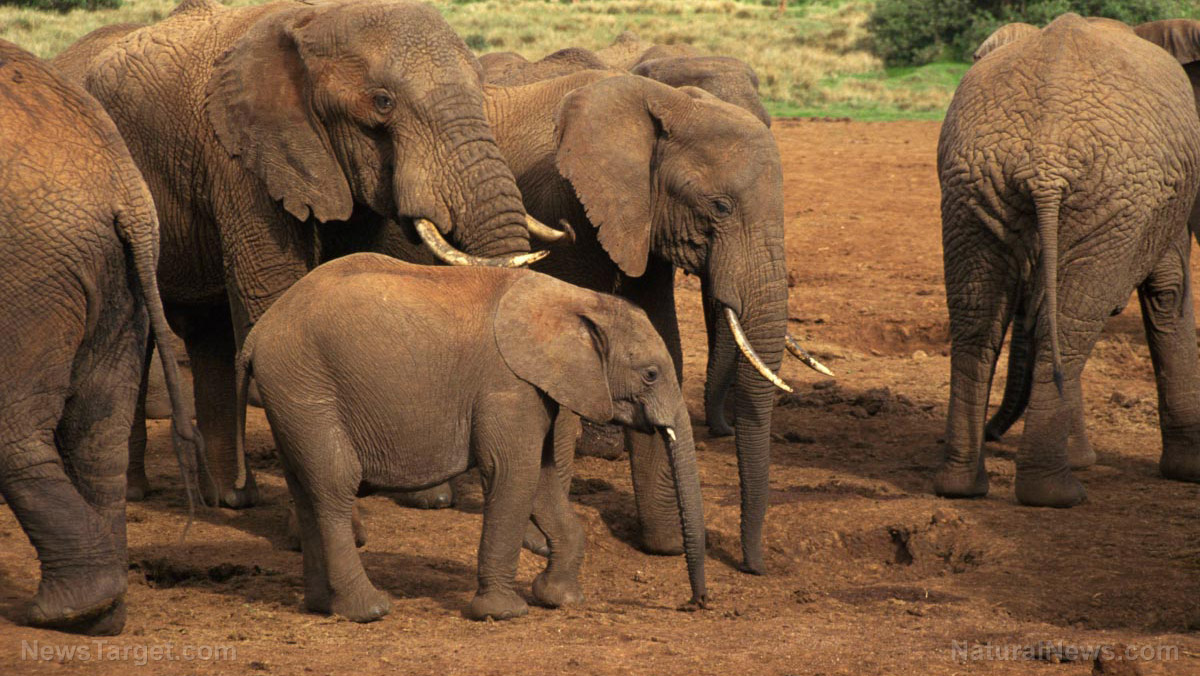Scientists discover that wild African elephants call each other by unique names
06/17/2024 / By Olivia Cook

Scientists from Colorado State University (CSU) have discovered that wild African elephants can call each other by unique names and the elephants being referred to respond to these calls.
The study published in Nature Ecology and Evolution found that these elephants use specific calls to address each other individually, which is a rare trait among non-human animals. This ability to use unique calls for communication highlights the intelligence of elephants and offers new insights into the evolutionary origins of language.
Researchers from CSU partnered with Kenya-based research and conservation organization Save the Elephants and Elephant Voices and used machine learning to analyze elephant calls. They confirmed that these calls included a unique identifier for the intended recipient.
This discovery was based on observations and experiments where recorded calls were played back to the elephants. When an elephant heard its specific call, it responded by calling back or moving toward the sound. However, calls meant for other elephants received little to no response.
Discovering name-like calls in elephants
Study lead author Michael A. Pardo, who conducted the study as a United States National Science Foundation post-doctoral researcher at CSU and Save the Elephants, noted that he and his team have long suspected that elephants might be using specific calls to address each other, similar to how humans call each other by names, but this idea had not been tested until now.
To investigate, the researchers followed elephants across the Kenyan savannah, recorded their vocalizations and noted, whenever possible, who made each call and who it was directed at.
Contrary to the common perception of loud trumpeting sounds, most elephant calls are deep, rumbling noises often below the range of human hearing. The team focused on these rumbles, hypothesizing that if elephants used names, they would likely be embedded in these calls.
The researchers reasoned that if rumbles contained name-like elements, they should be able to identify the intended recipient based solely on the call’s properties. They used a machine learning model for this purpose, feeding it data on the sound properties of each call along with information on the intended recipient. The model then tried to find patterns linking the calls to the identities of the recipients, using 437 calls from 99 different elephants for training.
Machine learning was essential because elephant rumbles convey multiple messages, including the caller’s identity, age, sex, emotional state and behavioral context. Names likely represent just a small part of these calls, and a computer can detect such complex patterns more effectively than the human ear.
The team did not expect every call to include a name, so they analyzed all rumbles where names might appear at least some of the time. The model successfully identified the recipient of 27.5 percent of the calls, which was significantly better than random guessing – indicating that some rumbles contained information about the intended recipient.
However, this result alone was not sufficient to prove that the rumbles contained names. The model might have identified unique voice patterns of the callers and inferred the recipient based on who the caller typically addressed.
In a subsequent analysis, the researchers found that calls from the same caller to the same recipient were more similar to each other than calls from the same caller to different recipients. This suggested that the calls were specific to individual recipients–akin to names.
To further validate this, the researchers played recorded calls to 17 elephants: One call originally addressed to them and another was addressed to a different elephant. The elephants responded more strongly to calls meant for them, approaching the sound source 128 seconds sooner, vocalizing 87 seconds sooner and producing 2.3 times more vocalizations. This demonstrated that elephants could recognize when a call was meant for them, even out of context.
Eavesdropping on the elephants
Study co-author George Wittemyer, a professor at CSU and chairman of the scientific board for Save the Elephants, explained that elephants are very expressive animals, and their reactions are easy to interpret for those who know them well.
When researchers played recordings of calls, elephants responded enthusiastically to the voices of their friends and family members. However, they did not react as strongly or move toward calls directed at other elephants, showing that they could recognize their own “names.”
When asked about the elephants’ reactions to hearing recorded calls, Pardo noted that the elephants might have been momentarily confused by the playback but eventually dismissed it as a strange event and continued with their activities.
The study also discovered that elephants, like humans, do not always use names when communicating. Using names was more common over long distances or when adults were communicating with calves.
This research, conducted over four years, included 14 months of intensive fieldwork in Kenya. The team followed elephants in vehicles, recording their vocalizations. They captured approximately 470 distinct calls from 101 unique callers, directed at 117 different receivers, in Samburu National Reserve and Amboseli National Park.
Scientists believe much more data is needed to pinpoint the exact names within elephant calls and to determine if elephants name other things they interact with, like food, water and places.
Collecting this data is challenging. “Unfortunately, we can’t have them speak into microphones,” noted Wittemyer, highlighting the difficulties in gathering enough information.
The study’s new insights into elephant intelligence and communication emphasize the importance of their conservation. Elephants are endangered due to poaching for ivory and habitat loss from human development. They require large areas to live and can sometimes damage property and pose risks to people.
Although the idea of conversing with elephants is still far off, Wittemyer believes that being able to communicate with them could significantly improve their protection. (Related: Animal feelings: Study reveals elephants mourn their dead like humans.)
Watch this video about elephants that lined up to hug a woman for 21 years.
This video is from the High Hopes channel on Brighteon.com.
More related stories:
Elephants pass the mirror recognition test, demonstrating higher animal intelligence.
Elephants know when it’s raining 150 miles away, study shows.
Sources include:
NewsMediaRelations.ColoState.edu
Submit a correction >>
Tagged Under:
Africa, African elephants, animal names, animals, breakthrough, conservation, discoveries, Ecology, elephants, environment, names, real investigations, research, weird science, wildlife
This article may contain statements that reflect the opinion of the author
RECENT NEWS & ARTICLES
COPYRIGHT © 2017 REAL INVESTIGATIONS NEWS




















